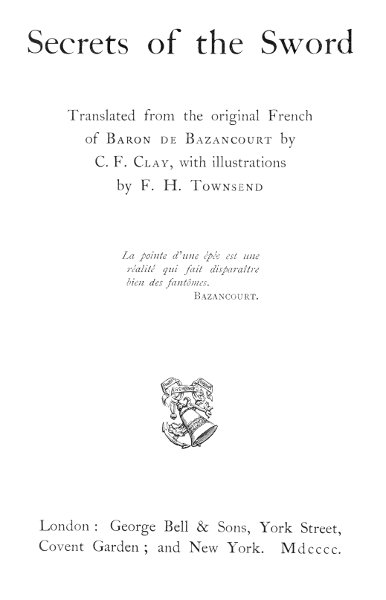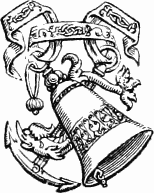Secrets of the Sword

Secrets of the Sword
Translated from the original French
of Baron de Bazancourt by
C. F. Clay, with illustrations
by F. H. Townsend
La pointe d’une épée est une
réalité qui fait disparaître
bien des fantômes.
Bazancourt.

London: George Bell & Sons, York Street,
Covent Garden; and New York. Mdcccc.
Cambridge:
Printed by J. and C. F. Clay
at the University Press.
PREFACE
If French is, as we have been told, the naturallanguage of the art of fencing, it seems aparticularly rash venture to translate a Frenchbook on the subject into English. This isespecially the case when the original is sucha work as Les Secrets de l’Épée, which so farfrom being a dry technical manual, that mightbe sufficiently rendered by a baldly literalversion, is one of those fascinating, chatty books,written in a happy vein, in which the manner ofwriting is the matter of principal importance.But the delightful ease and artful simplicity ofstyle that captivate the reader are the translator’sdespair. I have made the attempt formy own amusement, and I am publishing mytranslation because the original work, which wasfirst published in 1862 and reprinted in 1875,has been for some years inaccessible, and becauseI think it is a book that will interest Englishfencers.
An interesting and appreciative account ofthe book is given in the introduction to thevolume devoted to fencing in the BadmintonLibrary, together with some criticism of theauthor. The would-be fencer is cautioned thatthe Baron de Bazancourt is ‘a very expert literarydodger’ whose specious arguments must bestudied with the greatest caution. The warningnote is no doubt wise in a book intended for theEnglish fencer, for English fencing certainlyshows no tendency to be excessively correct, butis rather inclined to err in the other direction.But no fencer who reads the work attentivelycan fail to derive from it a real profit, and, Ihope, a real pleasure. The keynote of the bookis that a fencer must fence with his ‘head.’Bazancourt generally calls it ‘instinct,’ or ‘inspiration.’But call it what you will, there canbe no doubt that the continual tax that fencingmakes on the resourcefulness of the player givesit its subtle and enduring charm. The unforeseenemergencies that have to be faced, and thevarieties of play that are encountered in meetingdifferent opponents, make fencing of all sportsthe least mechanical and the least monotonous.
We are often told that fencing will never bepopular in England, because it is no longerrequired for practical purposes. But does anyonesuppose that we are guided by practical[Pg v]considerations in choosing our sports? Fencingis a most exhilarating exercise and one that isparticularly suitable for those of us who live atown life